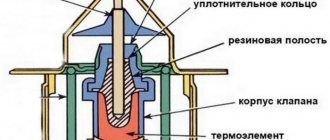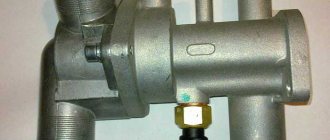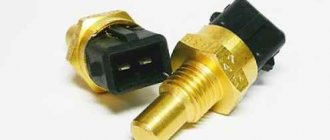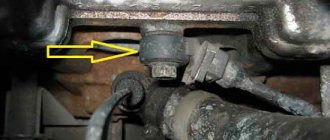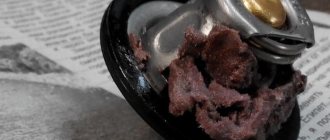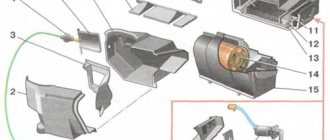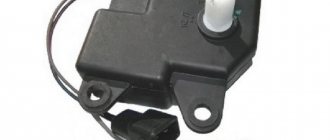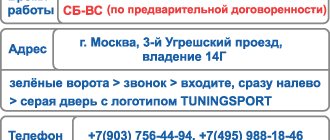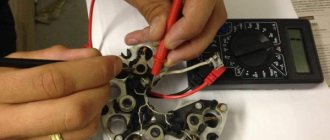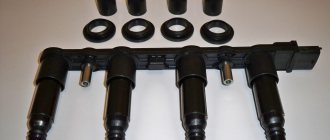Any engine requires cooling during operation. For this purpose, there are special channels in the block, and a thermostat is provided outside. The entire system is connected by pipes. Coolant circulation is ensured by a special water pump. People call it a pump. But that's not all. In order for the engine to warm up quickly, part of the liquid is forcibly “cut off” and does not circulate for a certain time. A thermostat is used to control coolant flows. Signs of its malfunction and the device are further in our article.
How it works?
Any engine uses two circuits:
Both contain coolant. However, after the engine starts, it heats up only in a “small” circle. This way the motor will quickly reach its operating temperature, which, as is known, is 80-90 degrees Celsius. The small circle is the heat exchanger of the stove and the engine itself. The second circuit includes a radiator with pipes, which has a large cooling area. This radiator is located in front of the engine. Additionally, air intake is provided by a special impeller. This could be a viscous coupling or an electric fan. But the operation of these elements no longer depends on the thermostat (the temperature sensor or the crankshaft drive belt is used here).
As you can see, the device has a simple operating principle. However, this mechanism sometimes fails. Signs of a malfunctioning thermostat installed on a Renault Logan are always accompanied by overheating. But first things first. So, below we will look at the main symptoms and signs of a thermostat malfunction.
Logan 1.6 has a copper thermostat. Its service life is quite long (10 years or more). But if it malfunctions, do not hesitate to replace it.
Methods for determining device malfunction
There are several ways to identify errors in the operation of the thermostat and eliminate the more serious consequences of its malfunction. For example, turn on the engine for a couple of minutes. If during this time the hose connecting the thermostat and the radiator manages to heat up, it means that there is a problem with the valve of the device. A hose of good design remains cold when the engine warms up briefly.
There are several ways to identify a thermostat malfunction, but it is best to seek help from a car mechanic.
There is another method to identify problems. The structure along with the thermometer is lowered into a special glass vessel with cold water. During the process of heating the water, it will become clear whether the unit is working properly or not. Sometimes a diagnostic scanner is used for such purposes.
To identify serious damage, it is recommended to seek help from specialists. They will help you resolve the problem in a timely and efficient manner.
Unit repair and replacement
Knowing why the thermostat does not work and what signs indicate its damage, you can begin repairs. If the breakdown is serious, the device is replaced with a new one. The new part must fully correspond to the failed structure. It is better to replace it when the engine has completely cooled down. In this case, you cannot do without special keys, sealant and a Phillips screwdriver.
You will need a 3-liter container. Cooled liquid will flow into it. Work on installing a new thermostat takes place in two stages: removing the damaged structure and installing a working device. The whole process will take at least 2 hours.
Removing the old part involves the following steps:
- Drain the cooled liquid into the prepared container.
- Removing the air filter.
- Unscrew the nut and 2 bolts from the inside of the engine compartment. After disconnecting, it is better to put these small parts in a visible place. This way they won't get lost.
- The connector is removed from the recirculation valve body, and the valve itself is removed along with the tubes.
- The connector is removed from the air flow sensor. The supply balloon is switched off.
- Then remove the filter.
- Using the existing keys, unscrew the nuts from the bottom and top of the thermostat. The structure is carefully pulled out of the nest.
Installing a new device involves performing all steps in reverse order. You can replace the structure yourself. Timely detection of malfunctions and repair of the thermostat improves the quality of vehicle operation.
“>
The engine does not warm up to operating temperatures
Oddly enough, these are also common signs of a thermostat malfunction. "Kalina" is also susceptible to this phenomenon. If the valve is stuck in the open position, the fluid constantly circulates in a large circle. The car will take a long time to warm up.
Even while driving, the engine temperature will not exceed 60 degrees. As you can see, overheating is not the main sign of a thermostat malfunction. VAZ classic models are no exception. The motor must operate within its range. Otherwise, the oil viscosity, film properties and valve clearances change. The engine is subject to increased loads.
Important
It is extremely important to diagnose and repair thermostat malfunctions in a timely manner. You cannot operate a vehicle with a damaged circulation control element. Insufficient heating of the power unit will affect power, dynamism, and increased fuel consumption. Excessive heating and frequent overheating with boiling of antifreeze can lead to problems with the piston group and depressurization of the cylinder head. Such repairs are very complex and expensive. On modern cars, any problems with the cooling system are transmitted to the engine control unit. The ECU will react to problems and make adjustments to the operation of other systems, which will affect the overall performance of the machine.
Symptoms of a faulty car thermostat
Considering the small number of functions assigned to the thermostat, it is quite easy to determine its malfunction. The fact that the car’s thermostat is completely out of order or partially fails to cope with the tasks assigned to it is indicated by the following:
The car engine slowly warms up to operating temperature or often overheats;
- After starting a cold engine, the lower radiator pipe becomes warm in 2-3 minutes or even faster;
- At the moment of acceleration, the engine temperature needle drops sharply, and at the moment the engine stops and runs at idle speed, it rises again;
- The engine is warmed up, but the lower pipe remains cold, and the engine begins to boil.
Based on the above, we can conclude that if there are problems with engine cooling, you must first pay attention to the correct operation of the thermostat.
Closed position
This malfunction occurs most often. The reasons for such a problem may lie in the nuances of operating the machine. The thermostat does not open if:
- Too much scale, dirt, and oxidation have accumulated in its mechanism. The reason may be the use of ordinary tap water instead of antifreeze. Many people dilute antifreeze with distilled water, which also leads to scale formation in the system.
- Inappropriate antifreeze has been selected for the cooling system. Coolants are divided according to the degree and temperature of heating. If the thermostat response threshold is many times lower than the boiling point of the antifreeze, the opening time of the regulator will increase, which will lead to overheating.
- The return spring breaks or loses tension. The cause may be the device itself if it is not manufactured to the required standards. Often new regulators from unscrupulous manufacturers suffer from this problem. The spring may wear out from using water for cooling. Water oxidizes and reduces the life of the metal.
- The thermostat does not open due to a broken valve cup mounting. The reasons are similar to a broken spring.
- Failure of the thermoelement. This part becomes unusable due to breakdown or deformation of the tube in which the wax is enclosed. This element is very sensitive, since its work is based on the pressure created during expansion from heating.
- Electronic thermostats suffer from the problem of complete jamming due to a faulty thermistor, oxidation of the power connector contacts, or an open circuit. Often the cause may be a temperature sensor that is unable to determine the current system temperature.
All these features must be taken into account in the process of selection and further operation of this unit.
Basic thermostat malfunctions
The thermostat is a fairly simple device that rarely fails. If you have problems with your thermostat, they are most often associated with the following reasons:
Before replacing the thermostat, check it (without dismantling, with dismantling)
Check without dismantling
The first option is the simplest. We start the engine, wait for the coolant temperature sensor needle to start moving (the engine starts to warm up), look under the hood (do not forget about precautions: remove long hair, scarves and other hanging clothing items so that they do not get into the moving elements of the engine) and Gently touch the radiator pipes with your hand, upper and lower.
If the lower pipe becomes warm in a short time after starting the engine (less than 2 minutes at a temperature of plus 20 degrees Celsius), this means that the thermostat is stuck in the open position - the coolant immediately flows through the large circuit. The coolant will take a long time to heat up, but the stove will not heat up.
If the thermostat remains in the closed position , the needle will quickly, in just a few minutes in the summer, go up to 90 degrees. The coolant circulates along a small circuit - inside the engine cooling jacket and through the heat exchanger of the stove. The engine will overheat very quickly.
see also
Auto parts from A to Z: Car design for beginners
With dismantling
But first of all, about safety: before dismantling the thermostat, you are strongly recommended to wear safety glasses and gloves. Now here's what else you'll need:
- Remove the thermostat (read below for how to do this);
- Find the temperature marking on the thermostat housing at which it should begin to open. Remember this temperature;
- Take a thermometer that can measure the temperature in boiling water;
- Then fill the pan with cold water. Place the thermometer in the pan and place it on the stove;
- Place the thermostat in a pan of cold water and turn on the stove;
- If the thermostat is working properly, then when the water reaches the temperature indicated on the thermostat body, it will begin to open. If this does not happen or the thermostat starts to come off when the water temperature reaches a higher temperature, then you will have to replace it with a new one.
Purpose and design features of the thermostat
The thermostat is designed to block the circulation of fluid through the cooling system until the car engine is completely warmed up in order to speed up this process and further maintain the required operating temperature.
Thermostat operating principle
is based on the melting of artificial wax placed in a small cylinder in the direction of the motor. Wax melts at a temperature of at least 80 degrees. At the same time, it expands, increasing in volume, due to which it squeezes the locking pin out of the cylinder, unlocking the thermostat valve and restoring circulation.
In general, a thermostat consists of:
- inlet pipe connected to the engine cooling system;
- bypass valve, which, if necessary, shuts off the small cooling circle;
- an outlet pipe connected to the coolant pump;
- spring holding the bypass valve;
- wax ball;
- inlet pipe connected to the radiator;
- springs holding the main valve;
- the main valve itself, designed to shut off the main circulation;
- piston;
- housings.
Before the engine warms up, the circulation of the coolant does not stop completely - it is carried out in a so-called small circle, where the coolant flows from the pump only through the cooling jacket and the heater radiator, so that the system does not stagnate. When the main circulation valve opens, the small circle is automatically closed.
That is, the entire thermostat device is actually just a cylinder, a return pin, wax and a number of minor parts. This simple thermostat circuit is effective and reliable, so it remains the same in most newer cars.
In different car models, thermostats are set to different opening temperatures, which are most often indicated on the device body. In addition, different cars can be installed with or without housing thermostats. Their main difference is the installation itself, either in the engine block, or in a separate housing, which is a complex two-level circuit.
Where is it located
There are many options for what will happen if the thermostat is constantly open on a large or small circle. This will lead to overheating, antifreeze may be released from the expansion tank, the normal pressure in the cooling system will change, and more.
This unit cannot be allowed to malfunction. It is used on all machines:
- on Kalina;
- on Priora;
- VAZ 2114;
- VAZ Classic;
- Ford Focus;
- VAZ 2110;
- Chevrolet Aveo;
- Gazelle Next;
- VAZ 2107;
- Lada Granta;
- Renault Logan, etc.
To check the serviceability of this element on a car, as well as to detect signs of a dying thermostat, you need to at least roughly understand where it is located.
I can't say it's difficult to do.
It is objectively correct to immediately look at the instruction manual. In the section where the cooling system is described, the location of the required element must be indicated.
At the same time, there is a fairly universal search method that is relevant for almost all domestic cars and many foreign cars.
To find a thermostat you need to do the following:
- open the hood;
- find the thickest pipe;
- this will be the radiator hose;
- it goes from the radiator to the engine;
- the second end of this pipe is connected to the thermostat;
- get to the second end;
- determine the location of the thermostat housing;
- start removing it.
